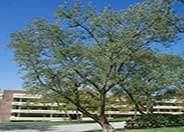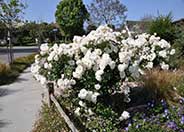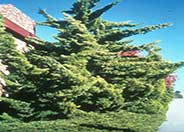
Common name:Olive
Botanical name:Olea europaea
This broad tree will grow to 40' tall and has small, gray green leaves with fleshy black fruit that appears in fall. Purchase fruitless varieties to avoid the mess.

Common name:Shrub Rose
Botanical name:Rosa Shrub varieties
The dark green, heavily veined leaves of this bushy shrub are strong support for the pure white or pink, nearly double flowers it produces. This is a very tolerant, heavily scented plant with an impressive fall color. Also, large hips appear intermittently with this plant.

Common name:Iceberg Floribunda Rose
Botanical name:Rosa 'Iceberg'
This is a shrub rose (there are climbing varieties) with an abundance of fragrant, medium sized, white blooms. It is one of the most popular roses and very tough.

Common name:Hollywood Twisted Juniper
Botanical name:Juniperus chinensis 'Kaizuka'
This wild-looking tree will give an artistic Japanese accent to any setting. It has an upright habit which includes broad, shrubby branches that spread irregularly but gracefully. Junipers are highly combustible plants.

Common name:Camphor Tree
Botanical name:Cinnamomum camphora
This beautiful evergreen tree has glossy foliage that is light green in color. The new foliage comes in with a tinted red color. Eventually, this tree becomes quite large in size (50'-60' tall and 60' wide).

Common name:Marina Strawberry Madrone
Botanical name:Arbutus 'Marina'
Marina Strawberry Tree (Arbutus marina) is a small-to-medium evergreen tree that is one of the most popular specimen trees for Southern California gardens. It matures at 40’ tall and 30’ wide and is easily kept in the 15’ range with regular pruning. It has a deep red bark and deep green foliage that resembles a Manzanita. This tree is appropriate in almost any garden setting with almost any soil or moisture level. When it is young, it grows quickly, so it benefits greatly from some selective pruning. The natural growth habit is more shrub-like, especially in the multi-trunk form, so removing some of the lower new branches and exposing the trunk will improve the look and shape. Once the tree canopy is out of reach, a licensed arborist should maintain the tree to keep its natural shape. This tree should be planted at least three feet away from any hardscape areas, eight feet from structures such as houses and buildings, and not near any powerlines. Shrubs and perennials should be planted about two feet away from this tree. It should be irrigated for about 45 minutes once a week when using most in-line drip irrigation systems. This tree is a hybrid of the Arbutus unedo. They share several traits, but the Arbutus ‘Marina’ grows faster and can reach a larger size at maturity. It also has a more reddish tone to its bark color.

Common name:Ground Cover Myoporum
Botanical name:Myoporum parvifolium
This great ground cover will grow 9" high and 9' wide and does well in partial or full sun with moderate watering. It produces delicate white flowers that bloom in summer and are surrounded by tiny, bright green leaves.

Common name:Parasol Aeonium
Botanical name:Aeonium arboreum
Parasol Aeonium is an upright succulent with rosette leaf clusters. It forms a mound and can be easily propagated by cuttings.
Designer: Barbara Lentz
Photographer: GardenSoft
Practice grass-cycling by leaving short grass clippings on lawns after mowing, so that nutrients and organic matter are returned to the soil.
Mulching and adding compost to soil can minimize evaporation and help soil absorb and store water.
Remove irrigation water and fertilizer from areas where you don't want weeds to grow.